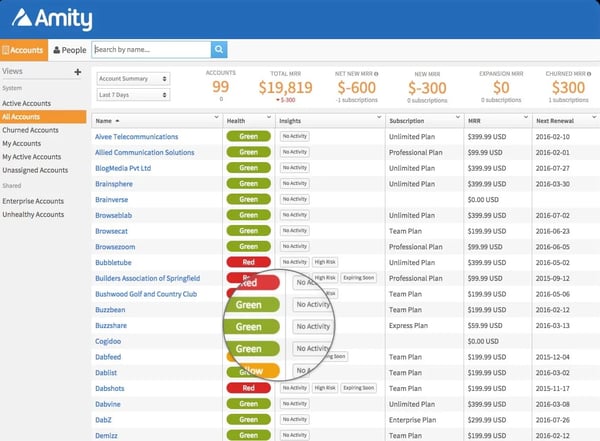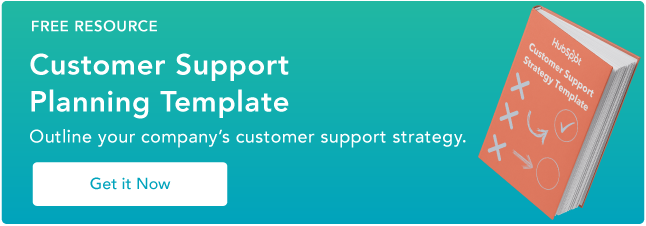What Is Customer Success?
According to HubSpot's VP of Customer Success, Eva Klein, "customer success is an organizational function that helps customers get maximum value out of a product or service, while working closely with sales, marketing, and product to achieve that goal." Customer success teams build mutually beneficial relationships that extend beyond the initial purchase. They focus on how the company can continue to best serve the customer, as well as provide above-and-beyond customer service.
Customer Success vs. Customer Service
You may be thinking -- "I already have a customer service team. What's the difference?"The difference between customer success and customer service is that customer success is a proactive function whereas customer service is reactive. If a customer has a problem with a product, they'll call customer service to fix it. Instead, customer success teams anticipate problems and reach out with solutions before they even occur. By doing so, you provide long-term support rather than short-term fixes.
Why Do you Need a Customer Success Program?
Increase Revenue
At HubSpot, our mission is to grow better with our customers because our research shows that growing companies prioritize customer success. In fact, HubSpot Research found that 70% of companies with growing revenue view customer success as "very important." Among companies with stagnating revenues, only 49% said customer success was "very important."
In the same report, HubSpot Research also found that 55% of expanding companies found it "very important" to invest in customer success programs -- whereas, only 29% of non-growing companies said these programs were "very important." From this research, it appears that companies who invest in their customer success teams tend to demonstrate an increase in overall revenue.
Upselling and Cross-Selling Opportunities
Customer success programs create more opportunities to communicate with your customers. A study conducted by Mainstay found that companies that added a customer success program demonstrated twice as many customer interactions than before. This increase provides additional chances for your team to upsell and cross-sell. A customer success manager can anticipate roadblocks that a customer will experience, then reach out to explain how your premium offers can help.
Decrease Acquisition Cost
When you help customers achieve their goals, they'll associate your company with their success. This reduces your customer acquisition cost because it increases your customer retention rates. Rather than searching competitors, customers will return to your business because they trust you're invested in their needs.
Additionally, happy customers like to share their stories of success and make recommendations to other customers. These people become brand evangelists who market your business to potential leads. This increases your customer referral rate, so you can reduce the time that you spend locating and attracting new customers.
Reduce Churn
Adding a customer success program should give you a better idea of which customers are likely to churn, and how you can prevent it. In the same Mainstay study, companies who added a customer success program were able to reduce churn rates down to about 2-3%. These companies set up customer playbooks and created automated alerts that indicated when a customer was likely to churn. This gave them more opportunities to nurture unsatisfied customers who could have taken their business elsewhere.
If your company still hasn't adopted a customer success program, check out these steps to build one for your business.
How to Build a Customer Success Program
1. Identify the customer's end goal.
The first step is to determine why customers are buying your product in the first place. For example, you probably wouldn't buy a wrench just because you wanted one. However, if you wanted to build that car, you'd likely need a wrench. Every customer has an end goal in mind when they make a purchase, so it's crucial that you determine where your product or service fits into that equation. Then you can use buyer persona tools to segment and organize customers by these desired outcomes.
One place to start is to identify the customers who would be the best fit for your customer service program. If you want to optimize your customers' chances of success, then you'll want to be sure you're targeting the most ideal candidates. You can conduct a customer behavior analysis to highlight these high-value individuals. You can also analyze metrics like social media mentions, product usage reports, and NPS® for data that identifies their end goal.
2. Build a customer success team.
To show customers that you take their success seriously, you'll want to invest in a customer success team. Without one, customers will view your new offerings more as suggestions rather than trusted steps to success. Building a customer success team demonstrates to the customer that you're dedicated to helping them reach their goals. As trust builds up over time, customers will be more likely to purchase additional products because of this relationship with your team.
When hiring a customer success manager, you'll want to find employees who are team players, as well as excellent communicators. A good place to start is by looking at your customer service department. These people have some of the strongest knowledge of your product, along with years of experience in dealing with customer roadblocks. Customer service employees are geared towards achieving customer success, so refocusing their efforts towards long-term solutions shouldn't be a tough transition.
3. Get the right tools.
Before you begin devising a strategy, you'll want to determine if your program is going to be manual or automated. Manual customer success programs require you to build the entire plan, then execute the actions on your own accord. Automated programs are software that help manage your customer success efforts, as well as make it easier to measure its impact. They can provide features like automatic alerts, and customer status reports, so you can keep track of every customer's progress. We'll provide some examples of these later in this post, but you'll want to consider if software is right for you prior to building your success program.
4. Develop a roadmap for success.
The next step is to outline the customer's journey and identify the opportunities where your business can make an impact. Refer to your customer journey map, and think about the challenges faced at each milestone. Then, determine the actions your company will take to ensure the customer's success at these roadblocks. If you're having trouble coming up with ideas, here are five things to consider:
- What's the desired outcome at each step in the customer's journey?
- What would benefit the customer most at each step?
- At what step(s) is your product or service falling short?
- At what point could your competitors influence your customers?
- How will you track customers who are unhappy with their progress in the customer's journey?
In this step, you'll also want to think about how your success team will communicate with customers. Some companies assign one rep per account, other companies rotate the accounts across one team. Additionally, it's important to consider the timing and channel that you'll use to communicate. You want your efforts to come off as helpful, so picking the right time and place to reach out is crucial.
5. Establish your metrics.
Before setting any changes in motion, you'll want to determine how you'll measure customer success. Since customer success is a mutually beneficial relationship, remember to include metrics that measure both the company's and the customer's success. For measuring the financial impact on the company, two customer success metrics that you can use are customer lifetime value and customer acquisition cost. When analyzing the impact on the customer, look at data like NPS, churn rate, and social media buzz. Through the combination of the two, you should get a clear idea of whether both parties are benefiting from your success team.
6. Make changes one at a time.
Once your customer success program is completely set up, it'll be tempting to let all your changes loose at once. However, at this point you'll want to be patient in your approach to minimize the chance of churn. Rolling out multiple changes at once can be overwhelming for customers, even if it's to their benefit. Additionally, it's more difficult to measure the success of each change if you unleash them all at once. Doing it one at a time gives you a better idea of what's working and ensures more consistent growth.
Implementing a customer success program can be a demanding task to undertake, but you can relieve some of the stress by using customer success software. If you're not sure which one is best for you, here are a few that we recommend.
Customer Success Software
1. HubSpot
HubSpot recently launched Service Hub, which includes a variety of customer success tools. Users can now enjoy free features like live chat, shared email inboxes, and service ticketing to help them nurture customers. You can also add a self-service knowledge base to your website in case your success team isn't available. HubSpot even offers chatbots which can be programmed to take a series of actions without the assistance of a rep.
Price: Starts free; premium tiers available

Source: HubSpot
2. Totango
Totango is a customer success platform that helps companies design and set up goals for their customers. Totango has tools that provide "health scores" which keep you updated on whether a customer is reaching their goals. The platform also allows for continuous testing and adjustments that can be applied at any point in the customer's journey.
Price: Variable

Source: Totango
3. Amity
Amity is a customer success tool that centralizes data from other software. It has a range of integrations available to pair with your Amity account which helps consolidate customer information. Once uploaded, Amity uses that data to set up playbooks and alerts in reaction to customer behaviors. The tool also has features that allow you to easily share its information with your entire company.
Price: Variable

Looking for more tools to measure customer success? Check out this post about other customer success tools we recommend.
Net Promoter, Net Promoter System, Net Promoter Score, NPS and the NPS-related emoticons are registered trademarks of Bain & Company, Inc., Fred Reichheld and Satmetrix Systems, Inc.
Customer Success
.png?width=112&height=112&name=Image%20Hackathon%20%E2%80%93%20Vertical%20(9).png)



![How To Write a CSM Resume [+ Free Templates]](https://53.fs1.hubspotusercontent-na1.net/hubfs/53/customer-success-manager-resume-1-20241031-2293336.webp)







